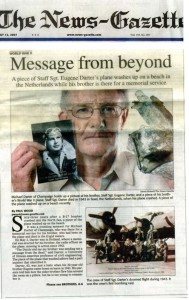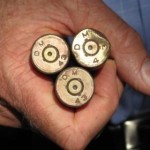

“Message From Beyond” headlines when a piece of the Lonesome Polecat II B17 was discovered on the nearby North Sea Beach just days before a scheduled memorial for the three MIA airmen. Also three of nine 0.5-caliber machine gun brass casing discovered later that were shot by the Polecat crew at attacking Nazi fighters 64 years ago
Every year, I would return to Texel Island to search for more information about my brother and his crew. I have met numerous people and government officials who were interested in the story and offered to help.
In summer 2006, the Bürgermeister of Texel was contacted and a memorial was agreed upon. It was to be held on May 4, 2007, which is the Netherlands’ Remembrance of the Dead (Memorial) Day. So the following year, I brought my entire family including my five children, grandchildren, and their spouses to the memorial. We all arrived on May 3, and we went to the WWII museum on the Island where friends were waiting to greet us. When we arrived, Johan Graas and Bram Van Dijk excitedly handed me a piece of deteriorated and damaged metal that they said was just discovered on the North Sea beach and brought to the museum for identification. They told me they thought it was a piece of my brother’s B-17.
Further investigation by experts showed that it was indeed one of four “trim tab hinges” on a B-17. It was stamped manufactured by Alcoa Aluminum and included a ball bearing for the hinge that was stamped “Made in the USA.” This “trim tab hinge” was found near the known crash site of the Lonesome Polecat II, my brother’s B-17, which lies about 1,000 ft out in the water.
The piece was found by Paul Dekker, a resident of Texel who goes to the beach often with his metal detector. Paul brought the piece to the museum when he noted identification numbers on it. They assured me that there are no other B-17 crashes in this area for miles around so it must be from the Polecat.
The ball bearing in the hinge is inscribed “Made in USA” and “FAFNIR”, which was the ball bearing company who manufactures ball bearings for aircraft engines and controls. This US company is still in business and their web site includes a photo of a B-17!
Can you imagine how we felt at that moment? Finding a piece of the aircraft sixty-four years after it crashed just off the Texel beach? Especially when this happened just a few days before a yearlong scheduled memorial for the crew who gave their lives? It was a very emotional and touching moment for our family. It also had a similar effect on the many Dutch people who attended the memorial the next day on Texel where it was shown. It was beyond words to express how we all felt.
The discovery of a piece of the Polecat on the beautiful Texel beach just days before the memorial was published in the newspaper headlines as “A Message from Beyond.” And indeed many there believed that it was a message from the three young men, who paid the ultimate sacrifice 64 years ago, and this was their response to us, their families, and crewmates that they knew of our search for them and that they were grateful for that!
The next year I was able to meet Paul Dekker and hear firsthand how he found the “trim tab hinge” on the beach. Paul also told us that since then, he also found several additional pieces of wreckage on the beach that belonged to the Polecat including three 0.5 caliber shell casings dated 1943 made in Des Moines, Iowa (DM) ammunition plant and a small piece of the windshield. To date, Paul has discovered nine of the shell casings on the beach and very generously given them to our family.
Each of these casings was shot by the crew at an enemy fighter attacking the Polecat. There were about 7,000 of these 0.5 caliber casings loaded on the Polecat at departure, and the crew shot several thousand of them at Nazi attackers during the time of intense combat when they were fighting for their very lives. Some of these shell casings were bent, indicating that the Polecat B17 crashed very hard and these casings were thrown violently around in the aircraft.
It’s impossible to describe how important these discoveries were to the Darter family, the other crewmember’s families, and the people who helped with the investigation. Everyone was touched by the discovery of an actual piece of the B-17 just a week before a long planned memorial. It made all of the time and cost of the cold case investigation worth it. To us, this was indeed a “message from beyond”. This was a message from the three MIA airmen to their families and crewmates, stating that they know of our love and how we respected them for their sacrifice to preserve our freedoms!
